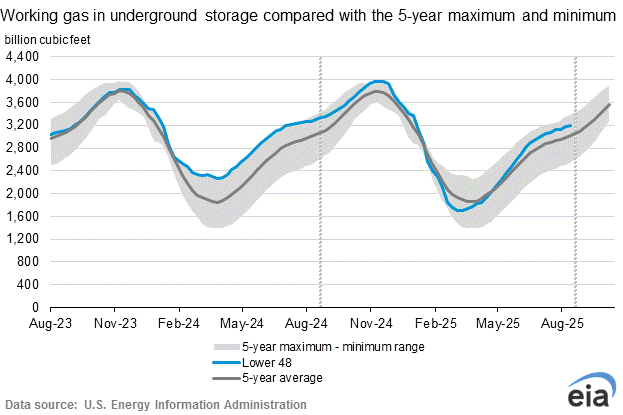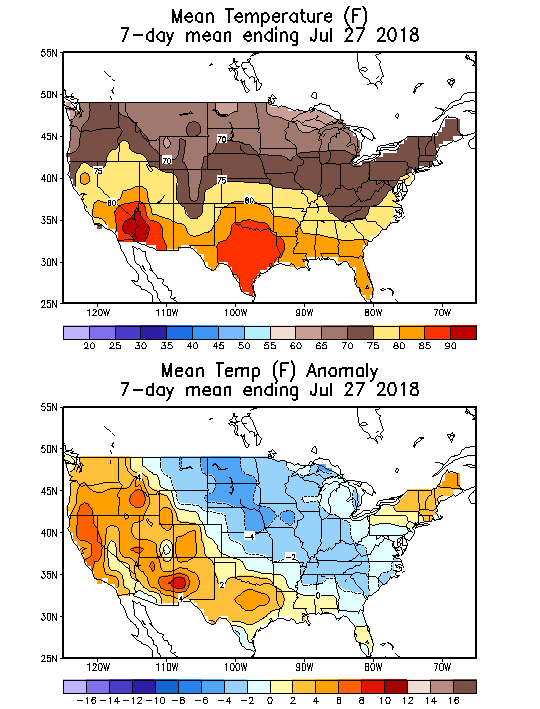
For weather that effects the natural gas market(Cooling Degree Days in the Summer help gauge residential natural gas use because natural gas is used to generate electricity for air conditioning:
https://www.marketforum.com/forum/topic/9525/
The forecast is MUCH warmer today..........which is why natural gas is higher.
From Natural Gas Intelligence:
September Natural Gas Called Higher as EIA Storage Reaction Continues
9:09 AM
September natural gas prices were set to open roughly 2 cents higher at around $2.835 as the market continues to digest the third straight bullish storage injection reported by the Energy Information Administration (EIA).
Storage is LOW for this time of year!! This is why the temperature forecast matterss.
Storage is at the bottom of the 5 year average:

EIA storage +35 Billion Cubic Feet-Very Bullish yesterday!
Heat in the West to TX caused drawdowns in the Pacific and South Central regions.
| Working gas in underground storage, Lower 48 states Summary textCSVJSN | |||||||||||||||||||||||||
|---|---|---|---|---|---|---|---|---|---|---|---|---|---|---|---|---|---|---|---|---|---|---|---|---|---|
| Historical Comparisons | |||||||||||||||||||||||||
| Stocks billion cubic feet (Bcf) | Year ago (07/27/17) | 5-year average (2013-17) | |||||||||||||||||||||||
| Region | 07/27/18 | 07/20/18 | net change | implied flow | Bcf | % change | Bcf | % change | |||||||||||||||||
| East | 552 | 527 | 25 | 25 | 647 | -14.7 | 650 | -15.1 | |||||||||||||||||
| Midwest | 552 | 524 | 28 | 28 | 752 | -26.6 | 707 | -21.9 | |||||||||||||||||
| Mountain | 146 | 145 | 1 | 1 | 200 | -27.0 | 178 | -18.0 | |||||||||||||||||
| Pacific | 250 | 257 | -7 | -7 | 293 | -14.7 | 313 | -20.1 | |||||||||||||||||
| South Central | 808 | 820 | -12 | -12 | 1,104 | -26.8 | 1,025 | -21.2 | |||||||||||||||||
| Salt | 203 | 214 | -11 | -11 | 298 | -31.9 | 279 | -27.2 | |||||||||||||||||
| Nonsalt | 604 | 606 | -2 | -2 | 806 | -25.1 | 746 | -19.0 | |||||||||||||||||
| Total | 2,308 | 2,273 | 35 | 35 | 2,996 | -23.0 | 2,873 | -19.7 | |||||||||||||||||
Prior to the report, consensus had settled around a build in the low 40 Bcf range, in line with the five-year average. Kyle Cooper of IAF Advisors had projected a 40 Bcf build, while Genscape Inc. expected a 45 Bcf injection. A Bloomberg survey had a range between 25 Bcf and 58 Bcf, with the median response of survey participants coming in at 43 Bcf. Intercontinental Exchange settled at 43 Bcf.
The EIA’s reported 35 Bcf build was 5 Bcf below projections by Bespoke Weather Services, which said “today’s print continues to demonstrate a tight market (albeit one that has loosened slightly from last week’s print).
These were the temperatures for the last 7 day period for that last EIA report.......hot in the West to TX..........much cooler, especially Midwest(N/C Plains were coolest but not many people live there-so not as much residential cooling demand in Summer)... so a much bigger injection was expected..........but did not come.

By WxFollower - Aug. 2, 2018, 4:03 p.m.
Today's EIA of +35 was, as noted by Mike, quite bullish. That includes in relation to the DJ news survey average, which had +44. So, it was a 9 bcf bullish miss for that. The prior two were also quite bullish with bullish misses of 10 bcf last week and 12 bcf the week before. One miss of 9 bcf is notable but I normally don't put too much weight on it for the longer term because of the chance of it being due to a statistical anomaly. However, three 9+ misses in a row in the same direction is very notable and significantly lessens the chance that there's merely a statistical anomaly.
When was the last times there were three weeks in a row that missed the DJ News survey average by 9+ bcf on the bullish side? Way back in November of 2011! Here is the data:
Week ending 11/11/11: actual missed 15 bcf to the bullish side
Week ending 11/18/11: actual missed 10.5 bcf to the bullish side
Week ending 11/25/11: actual missed 11 bcf to the bullish side
Natural gas breaking out to the upside? Got some tough resistance ahead but storage data and weather are bullish(increased supplies coming soon are bearish):
| Natural gas 3 months |
Naturalgas 1 year below
Naturalgas 5 years below
| Naturalgas10years below
|
Seasonals based on historical prices.
Hey Mike et al,
The semi-reliable/decent skill ensemble model consensus (GFS and Euro) for 0Z today vs 0Z yesterday was a few CDDs hotter for weeks 1 & 2, combined. That was enough when combined with follow through from yesterday's solidly bullish EIA to cause a pretty good rally this morning on top of yesterday's pretty strong rally on the EIA report, itself. The CFS is, as you showed, significantly cooler weeks 3-4 vs yesterday. The market didn't care much, if any, about it as it stayed strong. That model often bounces around like a ping pong ball like it has in recent days and is, therefore, hard for the market to take seriously most of the time. Also, it has a significant cool bias. As mentioned a few days ago, 30 year climatology is actually more accurate than the CFS by day 10! The market rallied on the slightly hotter much more reliable weeks 1-2 guidance and essentially ignored the cooler "entertainment" shown for weeks 3-4.
Now let's see what the 12Z model consensus will show.
By the way, thanks, Mike for all that you do at this board! You're awesome!
You're welcome Larry!
Am wondering if industrial demand is a bit stronger than expected and part of the increased demand that is causing these bullish surprises on the EIA storage reports.
I have not analyzed what regions are the most bullish with regards to guesses and don't know if its been consistently the same region(s) that are using up more gas than expected.
I do know that that we have been having drawdowns in the Southcentral and Pacific regions because of the intense heat from Texas to the West but the storage injection guessers have all known what the CDD's have been in the entire US for the past 3 weeks and would have dialed in the appropriate numbers, weighted for population in those areas.
I remember in late 2008 and especially early in 2009, we were having some pretty bearish(smallish) drawdowns for the amount of HDD's because of sluggish demand in the industrial sector as a result of the big economic slowdown.
It would make sense, right now if the opposite is happening............industrial demand for natural gas ramping up with the economy roaring. What do you think Larry?
Supplies have increased significantly. According to most accounts, supplies coming to the market have been setting records recently. Expectations for this growth to continue are what's keeping a lid on prices..........which should be at $3, one would think based on past low storage and forecast heat coming up.
Friday closing comments from Natural Gas Intelligence:
September Natural Gas Rally Continues; SoCal Cash Surges on Heat, Pipe Work
7:07 PM
September natural gas posted two consecutive days of solid gains, climbing 3.7 cents Friday to $2.853, as traders continued to react to the latest storage data, which reflected persistent deficits and potential end-of-season inventories that appear to be trailing many earlier market estimates.
Heat, Low Storage Levels No Match for Summer Natural Gas Futures Doldrums
“We estimate it is unlikely that storage will reach the five-year average (around 3.8 Tcf) this refill season, but we believe that investors are more comfortable entering the winter with storage below average” due to the much higher year/year (y/y) production (+8.3 Bcf/d in July), which is likely to continue to grow into year end 2018, analysts with Jefferies LLC said.
The EIA reported that in May, dry natural gas production increased year over year, the 12th consecutive month it has done so. The preliminary level for dry natural gas production in May was 2,491 Bcf, or 80.4 Bcf/d, which was 8.6 Bcf/d (12.0%) higher than the May 2017 level of 71.8 Bcf/d. The average daily rate of dry natural gas production for May was the highest for any month since EIA began tracking monthly dry production in 1973.
Meanwhile, Genscape Inc. said Lower 48 production closed July with a “solid recovery” from some late-month disruptions to lift the month’s final average to record highs. Its daily pipeline production estimate has July closing out at a daily average 80.27 Bcf/d. The month’s single-day high of 80.97 on July 4 established the all-time record.
The monthly average was nearly 1.18 Bcf/d greater than June’s average, driven primarily by about 0.5 Bcf/d of gains out of the Northeast and the Gulf of Mexico, “the latter being a product of restoration of
volumes from a handful of offshore platforms,” Genscape senior natural gas analyst Rick Margolin said.
At this point, production this summer-to-date is averaging 79.15 Bcf/d, almost exactly 7 Bcf/d greater than last year’s summer-to-date average. On a regional basis, the largest summer-on-summer gains are led by more than 3.85 Bcf/d of summer-on-summer growth in the Northeast, followed by 1.44 Bcf/d of growth in the Gulf Coast region and more than 1.1 Bcf/d of growth in the Permian.
“Add to this volumes produced in Western Canada, which are running more than 15.42 Bcf/d, a 0.73 Bcf/d increase on last summer to date,” Genscape said.
The only areas to report a summer-on-summer decline have been the Midcontinent, San Juan and the West (excluding Rockies), Genscape said. Its latest production forecast expects sustained growth through the summer and the rest of year, with the summer-on-summer surplus expected to further widen, “driven by completion of maintenance events and gas and oil forward curves continuing to indicate additional deployment of rigs,” Margolin said.
Still, Jefferies noted that natural gas power demand set a new monthly record, averaging 36.74 Bcf/d for July, just ahead of the prior record month of July 2016 at 36.66 Bcf/d. Total U.S. gas demand set a seasonal July record as well, at 78.4 Bcf/d, up 3.9 Bcf/d y/y. Other than power demand, liquefied natural gas (LNG) demand increased +1.1 Bcf/d y/y, residential/commercial demand rose +0.4 Bcf/d y/y and industrial demand increased +0.1 Bcf/d y/y, it said.
Furthermore, there have been some recent infrastructure additions on the demand side of the ledger which have helped to counter production growth, analysts at Houston-based Mobius Risk Group said. In addition, based on public commentary from producers, there could be less prolific supply growth in the later half of the year.
Already, there are signs in the Permian Basin that natural gas infrastructure may be running near capacity. Gas production climbed from 6.4 Bcf/d at year-end 2017 to 7.2 Bcf/d in March 2018, “but production has been roughly flat at this level for five months,” Jefferies said. Meanwhile, in the past several weeks, TransCanada Corp.’s El Encino-Topolobampo pipeline in Mexico, Cheniere Inc.’s Corpus Christi LNG feedgas volumes and Howard Midstream Energy Partners LLC’s Nueva Era pipeline have all started to aid in soaking up South Central U.S. production, Mobius said. Indeed, South Central storage is roughly 300 Bcf behind last year, EIA data show.
“The narrative this year has been focused on excessive associated gas production plus backhauled Appalachian production, and the subsequent glut of southern U.S. supply. However, current inventory levels and the fact that the y/y storage deficit in this region has not materially changed in the past six weeks suggests natural gas demand is not to be ignored,” Mobius analysts said.